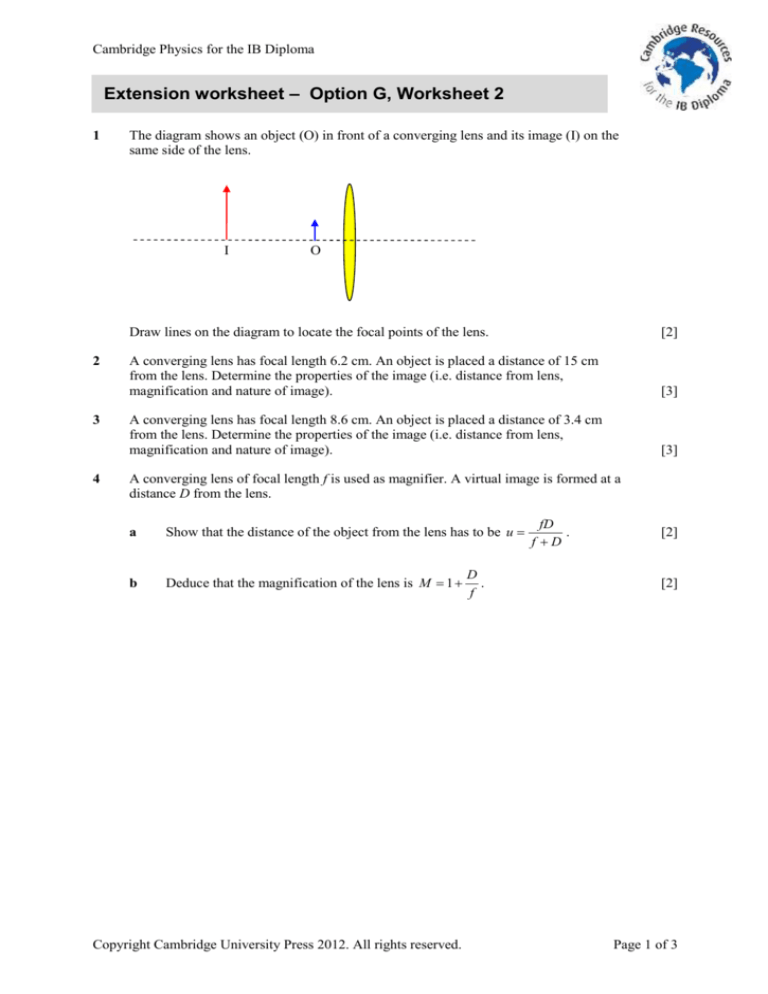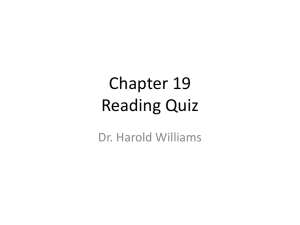
Cambridge Physics for the IB Diploma
Extension worksheet – Option G, Worksheet 2
1
The diagram shows an object (O) in front of a converging lens and its image (I) on the
same side of the lens.
I
2
3
4
O
Draw lines on the diagram to locate the focal points of the lens.
[2]
A converging lens has focal length 6.2 cm. An object is placed a distance of 15 cm
from the lens. Determine the properties of the image (i.e. distance from lens,
magnification and nature of image).
[3]
A converging lens has focal length 8.6 cm. An object is placed a distance of 3.4 cm
from the lens. Determine the properties of the image (i.e. distance from lens,
magnification and nature of image).
[3]
A converging lens of focal length f is used as magnifier. A virtual image is formed at a
distance D from the lens.
a
Show that the distance of the object from the lens has to be u
b
Deduce that the magnification of the lens is M 1
Copyright Cambridge University Press 2012. All rights reserved.
D
.
f
fD
.
f D
[2]
[2]
Page 1 of 3
Cambridge Physics for the IB Diploma
5
A compound microscope consists of two converging lenses. The diagram shows rays
refracting in the objective lens of the microscope and forming the intermediate image.
The final image is formed at a distance of D from the eyepiece lens.
D
a
b
By drawing lines on the diagram above construct the final image and hence
show how the two rays refract in the eyepiece lens.
[3]
Determine the position of the focal point of the eyepiece lens.
[2]
In a particular compound microscope the objective lens has a focal length of 2.0 cm
and the object is placed 2.5 cm from the lens. The focal length of the eyepiece lens is
6.0 cm and the final image is formed at the near point distance of D = 25 cm from the
eyepiece lens.
c
6
Determine the magnification of the microscope.
[3]
In the astronomical telescope below the final image is formed at infinity. Rays of light
form a very distance object enter the objective lens as shown. The focal point of the
objective, to the right of the lens, has been marked.
Copyright Cambridge University Press 2012. All rights reserved.
Page 2 of 3
Cambridge Physics for the IB Diploma
a
Draw lines to show the refraction of the two rays in the objective lens.
b
Continue the lines you drew in a to show the refraction of the rays in the
eyepiece lens.
[2]
The focal length of the objective is 120 cm and the power of the eyepiece is 50
dioptres. Determine the magnification of the telescope.
[2]
c
7
Monochromatic light of wavelength is incident normally on two very thin, parallel
slits that are d = 0.24 mm apart. Bright and dark fringes are observed on a screen a
distance of D = 1.80 m from the slits. The separation of two consecutive bright fringes
is s = 4.8 mm. The middle of the screen is directly across the middle of the slits.
a
[3]
Calculate the wavelength of light.
[2]
c
Draw a sketch graph to show the variation of the intensity of light with distance
from the middle of the screen.
[2]
The slit separation stays the same but the number of slits increases. Suggest
how the graph you drew in b changes.
[3]
Light of wavelength 540 nm is incident normally on a diffraction grating with 530
lines per mm.
a
b
9
Show that the separation of two consecutive bright fringes on the screen is
D
given by s
.
d
b
d
8
[2]
Calculate the angle between the first order (n = 1) and second order (n = 2)
maxima.
[3]
Determine the maximum number of orders that can be observed, in principle,
with this diffraction grating.
[2]
The spectrum of sodium contains two lines with almost identical wavelengths,
589.0 nm and 589.6 nm. Light from sodium is observed through a diffraction grating
with 660 lines per mm.
a
b
Calculate the angle between the two images of the two lines in the first and in
the second order spectrum.
[3]
Explain the advantage of viewing the two wavelengths in the second order
rather than the first.
[1]
Copyright Cambridge University Press 2012. All rights reserved.
Page 3 of 3









